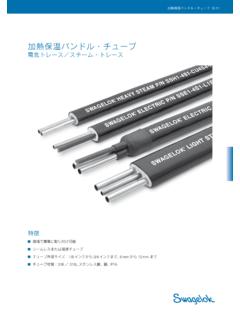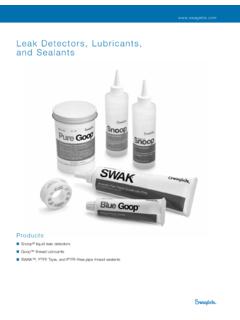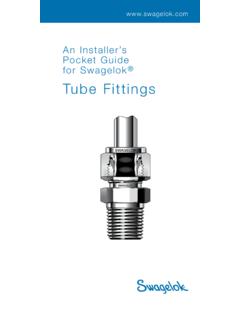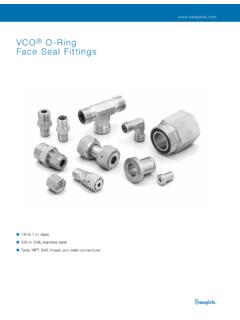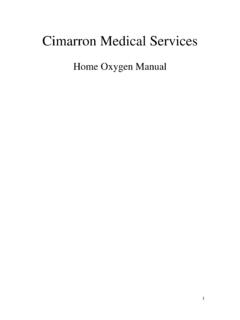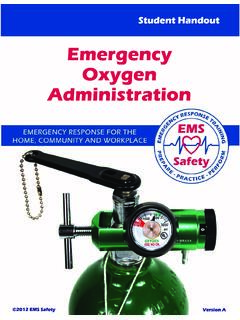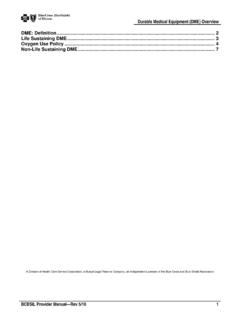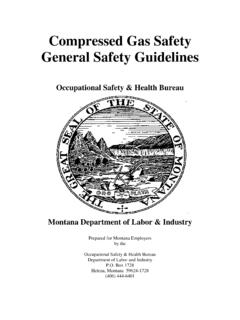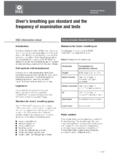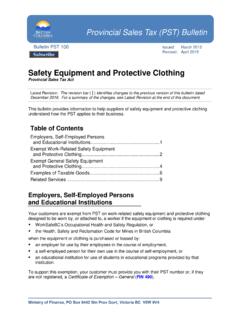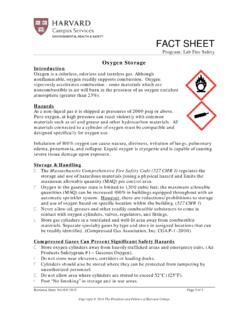Transcription of FITTINGSTUBE Pressure Regulators K Series
1 Pressure Regulators K Series 1 K SERIESREGULATORSP ressure Regulators K Series Pressure -reducing models Back- Pressure models Gas cylinder changeover model Vaporizing Pressure Regulators and FiltersK SERIESREGUL ATORSC ontentsOperation, 3 Selection, 3 Testing, 4 Cleaning and Packaging, 4 Features, 5 Pressure -Reducing General-Purpose (KPR Series ), 6 Two-Stage (KCY Series ), 8 High-Sensitivity (KLF Series ), 10 High-Flow, High-Sensitivity (KHF Series ), 12 Compact (KCP Series ), 14 Medium- to High- Pressure (KPP Series ), 16 High-Flow (KPF Series ), 18 High- Pressure (KHP Series ), 20 High- Pressure Hydraulic (KHR Series ), 22 General-Purpose (KBP Series ), 24 High-Flow, High-Sensitivity (KFB Series ), 26 Compact (KCB Series ), 28 High- Pressure (KHB Series ), 32 Medium- to High- Pressure (KPB Series ), 30 Back- Pressure Gas Cylinder Changeover (KCM Series ), 34 Electrically Heated Vaporizing (KEV Series ), 38 Steam-Heated Vaporizing (KSV Series )
2 , 36 Specialty Pressure -ReducingFlow Data Pressure -Reducing Regulators , 41 Back- Pressure Regulators , 49 Port Configurations, 52 Options and Accessories, 53 Maintenance Kits, 56 Pressure Regulators K Series 3 K SERIESREGULATORSP ressure-Reducing RegulatorsPressure-reducing Regulators control outlet Pressure by balancing an adjustable spring force against the forces caused by inlet and outlet pressures. The spring force is adjusted by turning the stem/handle, which sets the desired outlet Pressure . As inlet Pressure decreases, the force balance changes. To compensate, outlet Pressure will increase.
3 This supply- Pressure effect (SPE) is a function of the design and type of regulator. If a regulator is subjected to fluctuating inlet Pressure , and outlet Pressure variations are not desirable, a two-stage regulator is Pressure -Reducing RegulatorsGas Cylinder Changeover A two-stage gas cylinder changeover model automatically switches between two Regulator OperationRegulators reduce the Pressure of a gas or liquid from a source, such as a cylinder or compressor, to a lower value needed by a device, such as an analyzer. A Pressure regulator provides better resolution and control when its inlet and control range pressures closely match the Pressure requirements of the fluid handling system.
4 Resolution is the number of handle turns needed to adjust a regulator from its lowest to highest outlet Pressure setting. Control is the ability of the regulator to hold a given outlet Pressure set Vaporization Regulators are available with electric and steam heat to vaporize liquid samples or to preheat gas EffectSupply- Pressure effect (SPE) or dependency is a ratio describing the change in outlet Pressure per 100 psi ( bar) change in inlet Pressure . In other words, for every 100 psi ( bar) drop in inlet Pressure , the outlet Pressure will increase by X psi.
5 X is the SPE. For standard Pressure -reducing Regulators , the outlet Pressure increases as supply Pressure decreases. The opposite is true as supply Pressure increases. This effect can also be realized on system startup or regulator should be set to the off position before turning the supply Pressure on or off to prevent overpressurization of regulator diaphragms, outlet Pressure gauges, or other equipment downstream. When selecting an antitamper K Series Pressure Regulator Selection Outlet pressures up to 500 psig ( bar) require diaphragm sensing mechanism; outlet pressures above 500 psig ( bar) require piston sensing SensingPiston Sensing2 StageGas Cylinder ChangeoverElectrical VaporizingSteam VaporizingCompact, MPC PlatformMaximum Inlet Pressure psig (bar) Pressure Control Ranges, psig (bar)0 to.
6 2 ( )10 ( )25 ( )50 ( )100 ( )250 ( )375 ( )500 ( )750 ( ) Pressure -Reducing ModelsKPR 6000 (413) KCY KLF 3600 (248) KHF KCP KPP 6000 (413)KPF KHP 10 000 (689) KHR Specialty RegulatorsKCM 4351 (300) KSV 3600 (248) KEV Back- Pressure ModelsKBP Equal to Pressure control range KFB KCB KPB KHB 4 Pressure Regulators and FiltersK SERIESREGUL ATORST estingEvery swagelok K Series Pressure regulator is Pressure tested with and PackagingEvery swagelok K Series Pressure regulator is cleaned and packaged in accordance with swagelok Standard Cleaning and Packaging (SC-10) (MS-06-62).
7 Cleaning and packaging to ensure compliance with product cleanliness requirements stated in ASTM G93 Level E is available for brass and stainless steel swagelok Regulators . Cleaning and packaging in accordance with swagelok Special Cleaning and Packaging (SC-11) (MS-06-63), to ensure compliance with product cleanliness requirements stated in ASTM G93 Level C is available for select KPR, KCY, KCP, KBP, and KCB Series Service HazardsFor more information about hazards and risks of oxygen -enriched systems, see the swagelok oxygen System Safety technical report (MS - 0 6 -13).
8 Model, it is important to make sure that SPE will not cause excessive overpressurization on opening and closing of the supply RegulatorsBack- Pressure Regulators control inlet Pressure by balancing an adjustable spring force against the force of the inlet Pressure . The spring force is adjusted by turning the stem/handle, which sets the desired inlet Pressure . When the force caused by the inlet Pressure rises above the force of the spring, the regulator opens until the spring force and inlet Pressure are balanced again. swagelok Pressure Regulators are not Safety Accessories as defined in the Pressure Equipment Directive 2014/68/EU.
9 Do not use the regulator as a shutoff device. Self-venting and captured-venting Regulators can release system fluid to atmosphere. Position the self-vent hole or the captured vent connection away from operating personnel. See Venting Options, page 5, for more Control Ranges, psig (bar)Flow Coefficient (Cv)Page0 to ..10 to 1500 ( to 103)15 to 2500 ( to 172)25 to 3600 ( to 248)50 to 6000 ( to 413)100 to 10 000 ( to 689)1000 ( )1500 (103)2000 (137)3000 (206)3600 (248)4000 (275) 6 8 10 12 14 16 18 20 22 34 36 38 24 26 28 30 32 Pressure Regulators K Series 5 K SERIESREGULATORSS wagelok K Series Pressure Regulator FeaturesStop Plate This disc provides positive backup to the diaphragm in case of diaphragm Spring Turning the handle compresses the spring, pushing the poppet away from the seat and increasing outlet Cap The two-piece design provides linear load on the diaphragm seal when the cap ring is tightened.
10 Eliminating torque damage to the diaphragm during Damper The poppet damper keeps the poppet aligned and reduces vibration and resonance. StemFine-pitch threads enable precise spring adjustment with low Diaphragm The all-metal diaphragm acts as the sensing mechanism between the inlet Pressure and the range spring. The convoluted, nonperforated design ensures greater sensitivity and longer life. A piston sensing mechanism (shown below) can accommodate higher PistonThe piston is contained by a shoulder in the regulator body cap to prevent piston blowout if the regulator outlet is overpressurized.

